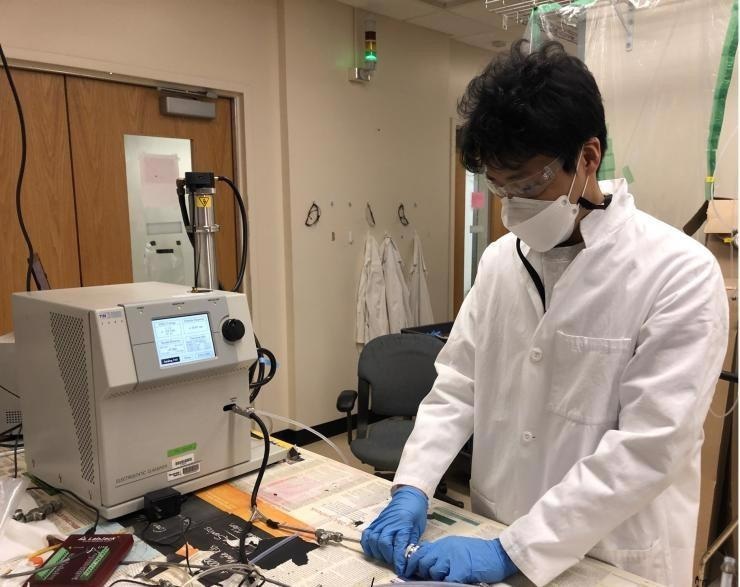Apr 5 2021
A new study by researchers from the Georgia Institute of Technology has found that wearing a face mask can safeguard a person and others from COVID-19, but the kind of material and how many fabric layers are utilized can considerably influence the risk of exposure.

Graduate student Taekyu Joo setting up the filtration efficiency measurement system. Image Credit: Fobang Liu, Georgia University of Technology.
The study quantified the submicron particles’ filtration efficiency of passing through a range of different materials. By comparison, a strand of human hair measures around 50 μm in diameter, and 1 mm is equal to 1000 μm.
A submicron particle can stay in the air for hours and days, depending on the ventilation, so if you have a room that is not ventilated or poorly ventilated then these small particles can stay there for a very long period of time.
Nga Lee (Sally) Ng, Associate Professor and Tanner Faculty Fellow, School of Chemical and Biomolecular Engineering and School of Earth and Atmospheric Sciences, Georgia Institute of Technology
The study was performed during spring 2020, when the pandemic set off a worldwide shutdown of a majority of the institutions. Various communities experienced a huge shortfall of personal protective equipment, which motivated several people to make their own homemade masks. Soon, Georgia Tech established the study as it already had “a great system for testing filtration efficiency using existing instruments in the lab,” recalled Ng.
The study results were utilized to form homemade face mask suggestions in April 2020, with the extensive study results published in the Aerosol Science and Technology journal on March 22nd, 2021.
Overall, the team tested 33 distinct commercially accessible materials not restricted to cloth fabrics, such as blended fabrics, single-layer woven fabrics like cotton and woven polyester, cellulose-based materials, nonwoven materials, several filter materials, and materials usually found and utilized in hospitals.
“We learned there was a lot of variability in filtration performance even in the same type of material,” stated Ng.
We found commercially available materials that provide acceptable levels of submicron particle rejection while still maintaining air flow resistance similar to a surgical mask. These materials combine fabric fiber density, a maze-like structure, and fiber surface chemistry to effectively reject submicron particles.
Ryan Lively, Associate Professor and John H. Woody Faculty Fellow, School of Chemical and Biomolecular Engineering, Georgia Institute of Technology
For homemade masks, the best-performing materials were sterilization wrap and blackout drapery utilized extensively for packing surgical instruments. Both materials are available on the market.
According to the team, people must avoid making use of filters like HEPA/MERV or vacuum bags until they are certified to be fiberglass-free because such filters might usually discharge glass fibers on their own that could be inhaled. Batting fabric, loose-knitted material, fleece, felt, or shiny, reusable shopping bags are other materials that should be avoided for masks.
The performance of multilayered samples was much better when compared to single-layer samples, but people must give attention to breathability. The two-layered and three-layered samples that were tested exhibit an overall filtration efficiency of around 50% for submicron particles. Furthermore, mask fit is essential as particles have the ability to easily escape via gaps at the nose or via the sides of the mask.
The analysis indicated that correctly fitted and multilayer masks arrest 84% of particles ejected by a person when one person wears it. Two people donning such types of masks decreases particle transmission by around 96%.
A concluding finding of the study was the significance of universal mask-wearing.
The best way to protect ourselves and others is to reduce exhaled particles at the source, and the source is our face. That really gets amplified when everyone starts wearing masks.
Nga Lee (Sally) Ng, Associate Professor and Tanner Faculty Fellow, School of Chemical and Biomolecular Engineering and School of Earth and Atmospheric Sciences, Georgia Institute of Technology
Ng expressed confidence that the study results will encourage people to embrace mask-wearing more extensively if they are unwell and need to be in public.
Ng added, “Not everyone understands the importance of airborne virus transmission, and the importance of wearing a mask. I hope that the practice will continue to help reduce the release of these viral particles into the environment and help protect others.”
Besides Ng and Lively, the team included Taekyu Joo, Masayuki Takeuchi, Fobang Liu, Matthew P. Rivera, and Bahnisikha Dutta from Georgia Tech; Joy Barr and Eric Parker from theClubhou.se; Emily S. Blum and John H. Tipton from the Global Center for Medical Innovation; and Julia Varnedoef from Cobb County (Georgia) Schools.
This study was financially supported by the Center for the Science and Technology of Advanced Material and Interfaces (STAMI) at Georgia Tech.
Journal Reference:
Joo, T., et al. (2021) Evaluation of Particle Filtration Efficiency of Commercially Available Materials for Homemade Face Mask Usage. Aerosol Science and Technology. doi.org/10.1080/02786826.2021.1905149.